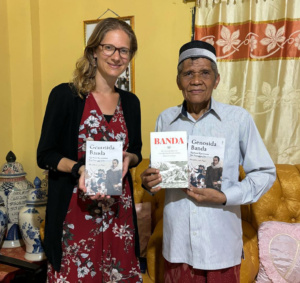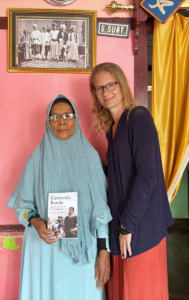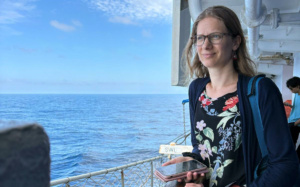Jan Pieterszoon Coen’s attempt to commit genocide on the Bandanese has failed
The original Bandanese live on as the Wandanese on the Kei Islands
Omniboek, Marjolein van Pagee, March 14, 2024
[This article was first offered as opinion piece to Dutch newspaper Trouw, but they were not interested in publishing it.]
 Last January the Indonesian translation of my book Banda. The genocide of Jan Pieterszoon Coen was released in Jakarta under the title: Genosida Banda. Kejahatan Kemanusiaan Jan Pieterszoon Coen. When my book first came out in 2021 it was exactly 400 years ago that Coen went to the Banda Islands to commit a genocide there.
Last January the Indonesian translation of my book Banda. The genocide of Jan Pieterszoon Coen was released in Jakarta under the title: Genosida Banda. Kejahatan Kemanusiaan Jan Pieterszoon Coen. When my book first came out in 2021 it was exactly 400 years ago that Coen went to the Banda Islands to commit a genocide there.
While I was in Indonesia for the book launch, Banda made the national news in the Netherlands again. The reason was a council meeting in the city of Hoorn that focussed on the question whether Coen’s statue should be demolished or not.
With the comment that Coen was “a bit of a rascal”, Dutch TV-comedian Arjen Lubach tried to make people laugh. A “bit of a rascal” because, according to Arjen, Coen had exterminated the original population of Banda. Nationwide, the message was repeated for the umpteenth time that 14,000 of the 15,000 Bandanese were murdered by Coen. Dutch news platform WNL: “The few inhabitants that survived ended up in slavery.”
Dutch people who argue for the removal of the statue because Coen is guilty of genocide, equally emphasize that there were virtually no survivors left. Harry Westerink, for example, member of the Werkgroep Slavernijverleden Hoorn (Slavery History Working Group Hoorn) and activist for Doorbraak, was one of the speakers during the council meeting who stated that Coen murdered an estimated 15,000 Bandanese.

This is not right. In east Indonesia, on the Kei Islands, there is a Bandanese community, direct descendants of those who left 400 years ago to escape the genocide. When my book came out, I already pointed out how their existence is being erased in the Netherlands. My hope was that my book, and the publications that came along with it, would change this.
Unfortunately, four years later, most Dutch people still refuse to recognize that there is something like a Bandanese diaspora on Kei who identify as “Wandan”, after Banda’s original name.
After a book tour on Java, I also visited the Kei Islands myself to hand over the book to Rat War, the current leader of the Wandan community. “Coen gagal,” I was reminded of several times, “Coen has failed, we have not been exterminated.”
Throughout the Moluccas there are quite a number of people who, in one way or another, are related to the original Bandanese and who can prove this by their family tree. For that reason alone, the statement that almost all Bandanese in 1621 were killed and that only a few managed to escape, is incorrect. A significant part was not present on the islands when Coen arrived with his fleet.
Long before the arrival of the VOC, the Banda Islands were an international trading hub. Not only did foreign traders come from far and wide to the islands, the Wandanese themselves also traveled and settled in other places where they mixed with the local population. This explains why there are still many Wandan descendants to this day.

However, only on the Kei Islands there is a Wandan-community whose ancestors left because of the genocide in 1621. Since then, they live there in the villages of Banda Ely and Banda Elat. In addition, seven Wandan-kampongs (city neighborhoods) have been built in the city of Tual. In general, they prefer to marry within their own community and are therefore less “mixed” compared to other Wandanese in the archipelago. People from the Wandan community on Kei emphasize that the departure from Banda was not a hasty flight but a deliberate choice to safeguard the survival of Islam, their family tree, their culture and history. They use the Islamic term “hijrah”.
In contrast to the mixed Wandanese diaspora who spread throughout the Indonesian archipelago because of trade or other reasons, the Wandan-descendants in the villages on Kei still speak the original language. There, the history is passed on from generation to generation through songs, sang by the women. In the village of Banda Ely I met Ms. Hj Sribunga Uar who sang: “Jan Pieterszoon Coen came to rob our nutmeg, but we children of Wandan did not want to be colonized.”
Because you have to go to the Kei Islands to meet the descendants of those whom Coen expelled in 1621, I did not visit Banda. Yet, the ferry did pass the islands very close. I saw them with my own eyes. The Wandanese told me that, despite centuries of separation, they still feel strongly connected to their land. When young Wandanese children visit the islands for the first time in their life, they have to walk barefoot to physically connect with the ancestral land that was taken from them. As a ritual a bit of soil is being put on their foreheads. I witnessed how many Wandanese are still moved to tears when talking about the genocide.

Apparently for people in the Netherlands, it is extremely difficult to recognize the existence of Wandan. It can no longer be that people don’t know about it. Dutch historians, journalists and activists concerned with Banda must have heard about my book in which the erasure of Wandan is a central theme. My book was sold relatively well and received quite some media attention, as reviews were published in several leading newspapers.
My suspicion that the historical erasure of Wandan in the Netherlands is a deliberate act, was confirmed by the Indonesian reaction to my book, which was very different. Here in Indonesia, journalists publish one article after another to correct the historical erasure of Wandan. I wonder: why is it that Dutch people continue to repeat the persistent lie that Coen massacred almost all Bandanese and that almost no one survived? Is it that we find it uncomfortable to admit that we, Dutch people, have been falsifying history and erasing them for 400 years?
—
See also:
Containing bias, colonial historical sources need to be criticized
